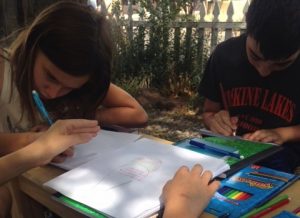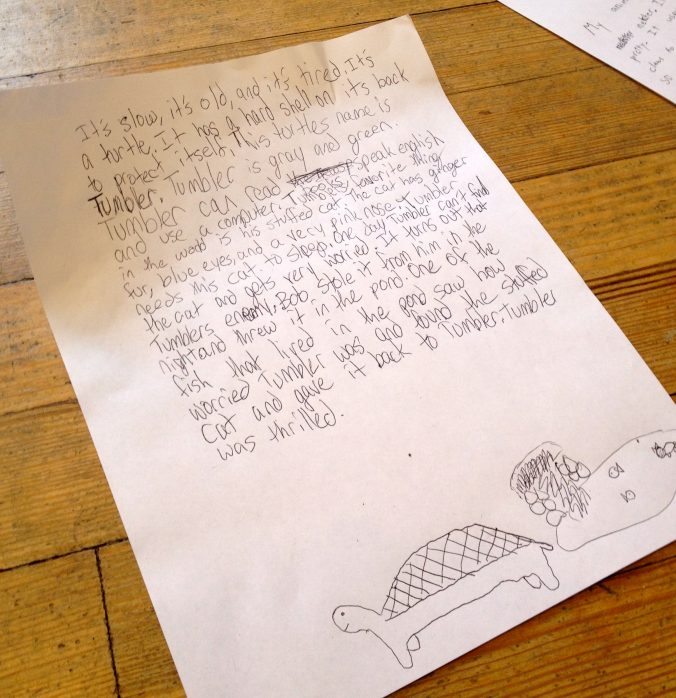Bee Hive is hosting its third summer of Creative Writing Workshops for kids. It is a favorite time of welcoming a special kind of artistic awesomeness into the store. We’ve had tales of super power-induced pets, time travel adventures, magical neighbors, food that flies, invisible friends – the list goes on – waft from kids’ imagination and into the walls and floor boards of the store. I think with all the magic that has been conjured up – Bee Hive is officially an enchanted cottage.
So, clearly, in our eyes, a kids’ book store and kids writing go hand in hand. But take that part away. Take Bee Hive out of the equation and, really, with everything else kids have going on these days – what’s the big deal about writing? Why add another thing to their busy lives?
Some of the things we’ve experienced through creating a space for kids to write have been, at times, awe-inspiring.
The first big one is imagination. Writing is like play-time for the brain. Coming up with alternate universes, characters, and whatever magic or fantasy they are focusing on, allows kids to think outside the box. It gives them an outlet for all the cool creative energy bubbling inside their heads. My 9-year-old daughter has written stories about a coin family, her brother as a fox (wearing purple socks), and Super Germ. This is stuff that needs to be encouraged before it becomes stifled by other things. It is pure, sweet, greatness.
Another one is the simple fact that creative writing develops reading, writing, and learning skills. Writing makes kids greedy for words. They start wanting to know how the dictionary works. And what’s a thesaurus? And how do you spell this? And can I use this word here? It is learning in its most organic form. As J.K. Rowling once said, “I always advise children who ask me for tips on being a writer to read as much as they possibly can. Jane Austen gave a young friend the same advice, so I’m in good company there.” Reading is essential to writing.
By creating something unique, writing develops self-confidence and identity. Not only do kids learn about themselves but they see what they are capable of creating. “There’s really something magical about writing a full page of text at this age!” says Rachel Miller-Howard, Bee Hive’s first resident writing instructor. The more they do, the more they want to do. “I always appreciated the kids’ enthusiasm about sharing work,” says Rachel. And this just grows as their confidence does.
“This is stuff that needs to be encouraged before it becomes stifled by other things. It is pure, sweet, greatness.”
Creative writing teaches empathy. When kids create characters, they have to put themselves in their shoes. What are they thinking? How are they feeling? It helps them see that the world is different when seen through eyes other than their own.
And, a super important thing to consider, is that writing is an emotional outlet. It can be weird and scary to be a kid, and writing is an opportunity to express certain thoughts and ideas in a safe way. Maybe they create a character that lives out emotions that they are feeling. Or situations that they’ve experienced and are confusing. “In one workshop, we started working with an image of an abandoned house that sparked conversation. It was hugely symbolic and provoked emotions of being lonely, scared, and sad. It really resonated with the kids,” explains Krista Isaksen, another former Bee Hive creative writing instructor. Writing is an amazing tool for sorting out and processing big things.
Having said all this, which is all really important – the bottom line is, its fun. It’s fun to play around in a world that you create. To be the master of your own universe. To be caught up in a reality that you are in control of – when in your other reality, you’re not so much so. To be free to make your characters blue; or dogs and pigs best friends; or parents that are invisible; or cars that run on grape juice. This is awesome stuff!
How can you encourage your kids to write? Really all it takes is a little creativity on your part. At Bee Hive, we love combining writing with visual projects. “It’s like their heads are full of stories, but they’ve only got the basic writing tools down, so including illustration affords a broader opportunity to express themselves,” explains Rachel.
Another easy thing to do is to watch for things in books that either you are reading together or they are reading on their own that is really making an impression on your kids. For instance, on a recent road trip, we listened to the audio version of The Penderwicks by Jeanne Birdsall, which has a lot of dialogue. Afterwards, my son was going around finishing people’s sentences with – “said, mommy”. Or, “said, Olive”. Or if he just said something, he’d tag it with, “said, Cash” (Annoying? Nooooo!) He really tuned into that structure. Or maybe your child really got into the butt-kicking princess character in The Princess In Black, you can suggest that she write a story with her own butt-kicking character – nothing wrong with giving your kids writing ideas and empowering them along the way. Or maybe your kids are enamored with time travel or animals with human qualities. Encourage them to create their own stories using these elements, perhaps using a visual aspect to get them going.
And, as we’ve experienced, workshops are magical. As well as important for community building. Helping kids find their tribe. Krista recalls, “One of the kids at a workshop declared to the other students, ‘You are so weird in the best way’. Meaning they were just like her.”


Recent Comments